Abstract
BACKGROUND: Adipose and muscle tissues express an insulin-sensitive glucose transporter (GLUT4). This transporter has been shown to translocate from intracellular stores to the plasma membrane following insulin stimulation. The molecular mechanisms signalling this event and the details of the translocation pathway remain unknown. In type II diabetes, the cellular transport of glucose in response to insulin is impaired, partly explaining why blood-glucose levels in patients are not lowered by insulin as in normal individuals. MATERIALS AND METHODS: Isolated rat epididymal adipocytes were stimulated with insulin and subjected to subcellular fractionation and to measurement of glucose uptake. A caveolae-rich fraction was isolated from the plasma membranes after detergent solubilization and ultracentrifugal floatation in a sucrose gradient. Presence of GLUT4 and caveolin was determined by immunoblotting after SDS-PAGE. RESULTS: In freshly isolated adipocytes, insulin induced a rapid translocation of GLUT4 to the plasma membrane fraction, which was followed by a slower transition of the transporter into a detergent resistant caveolae-rich region of the plasma membrane. The insulin-stimulated appearance of transporters in the caveolae-rich fraction occurred in parallel with enhanced glucose uptake by cells. Treatment with isoproterenol plus adenosine deaminase rapidly inhibited insulin-stimulated glucose transport by 40%, and at the same time GLUT4 disappeared from the caveolae-rich fraction and from plasma membranes as a whole. CONCLUSIONS: Insulin stimulates glucose uptake in adipocytes by rapidly translocating GLUT4 from intracellular stores to the plasma membrane. This is followed by a slower transition of GLUT4 to the caveolae-rich regions of the plasma membrane, where glucose transport appears to take place. These results have implications for an understanding of the defect in glucose transport involved in type II diabetes.
Full text
PDF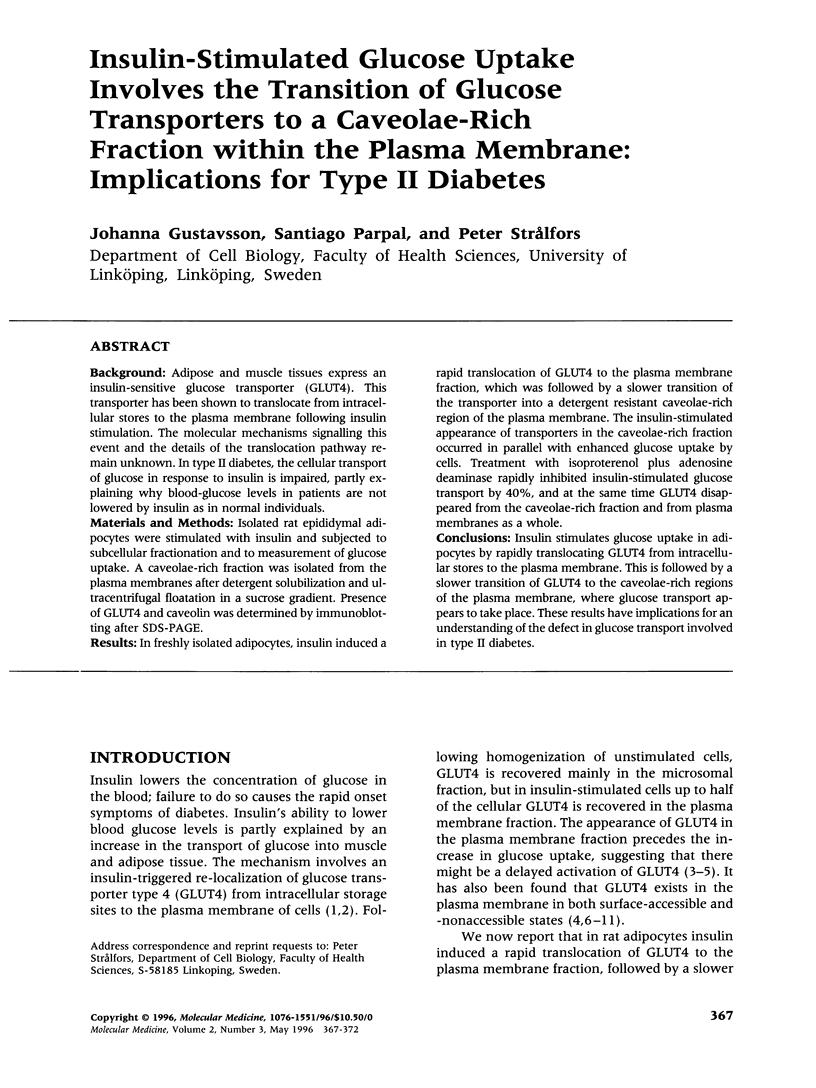
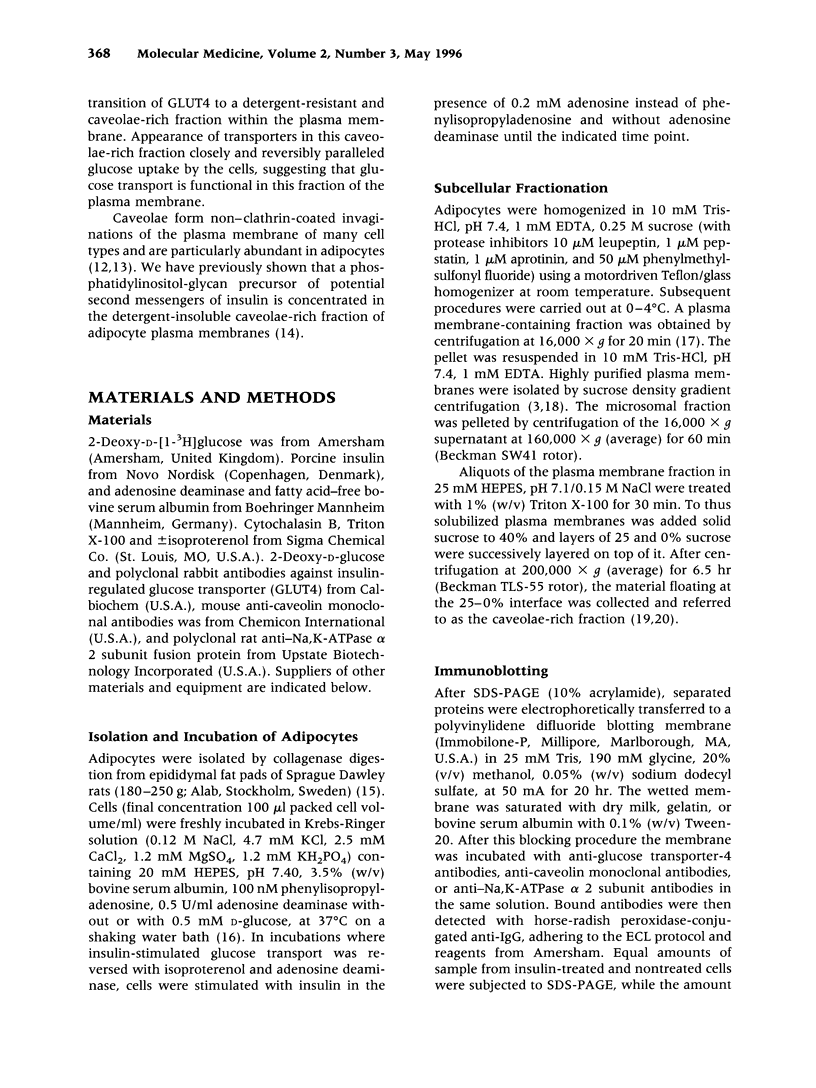
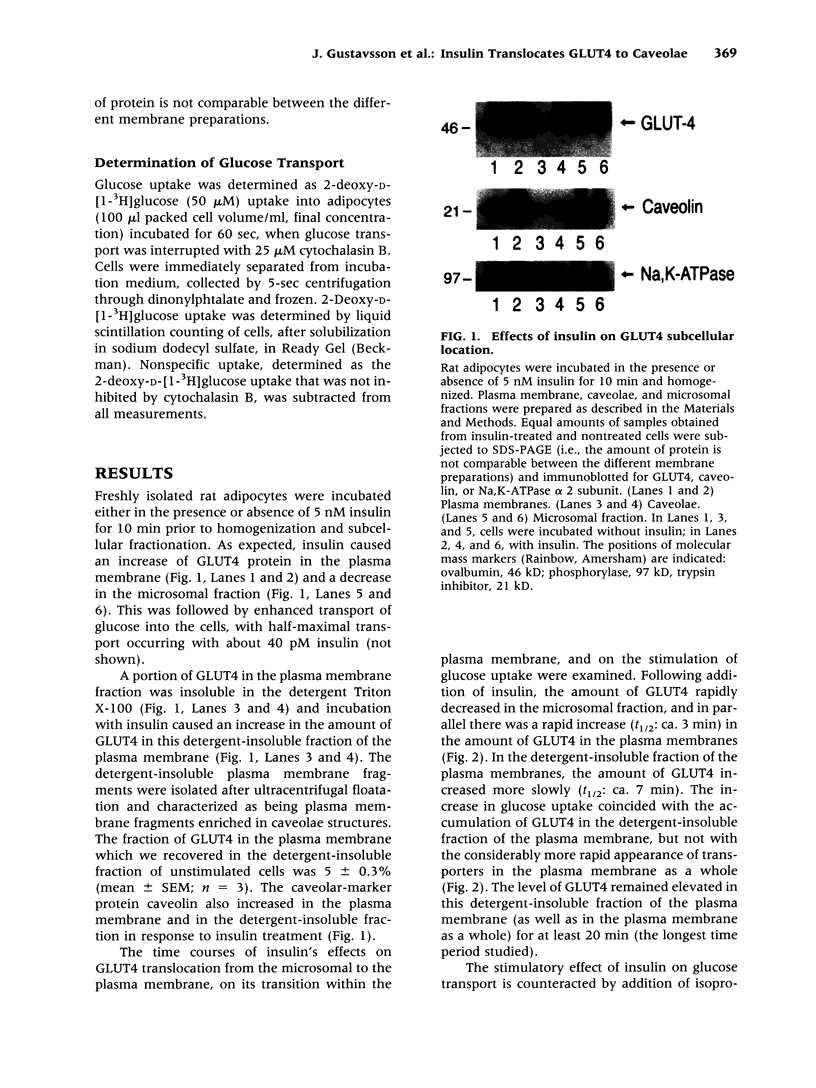
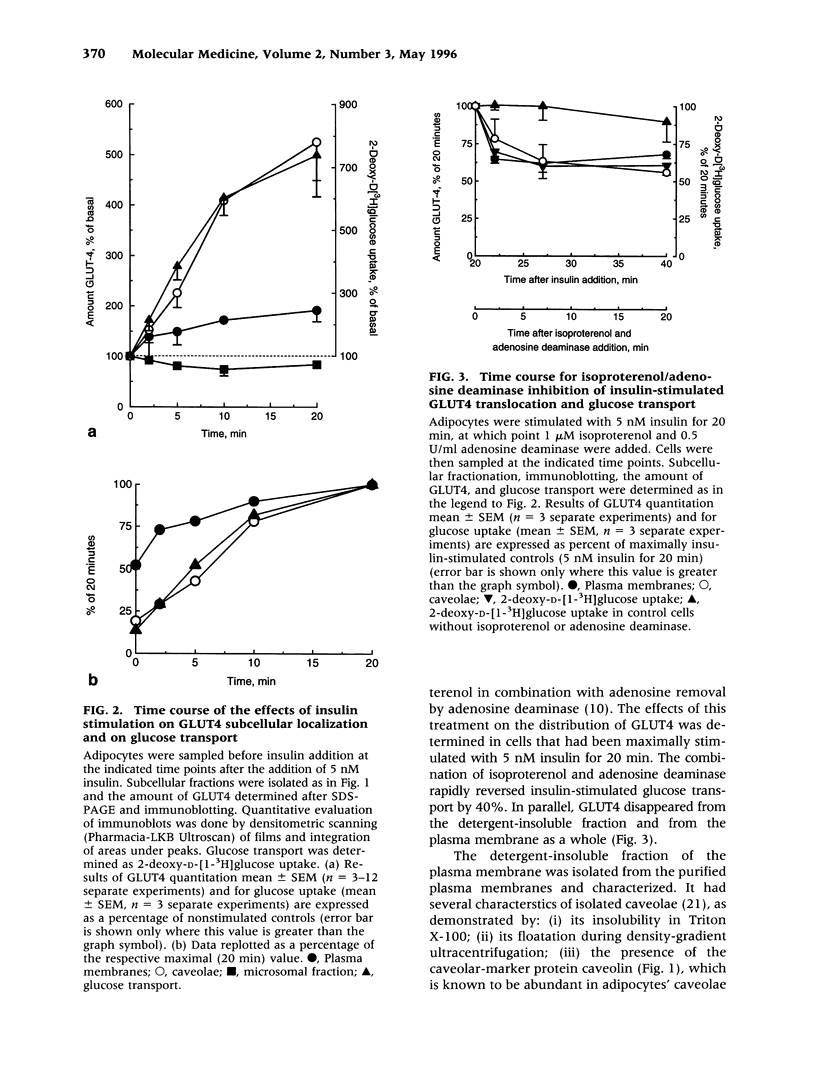
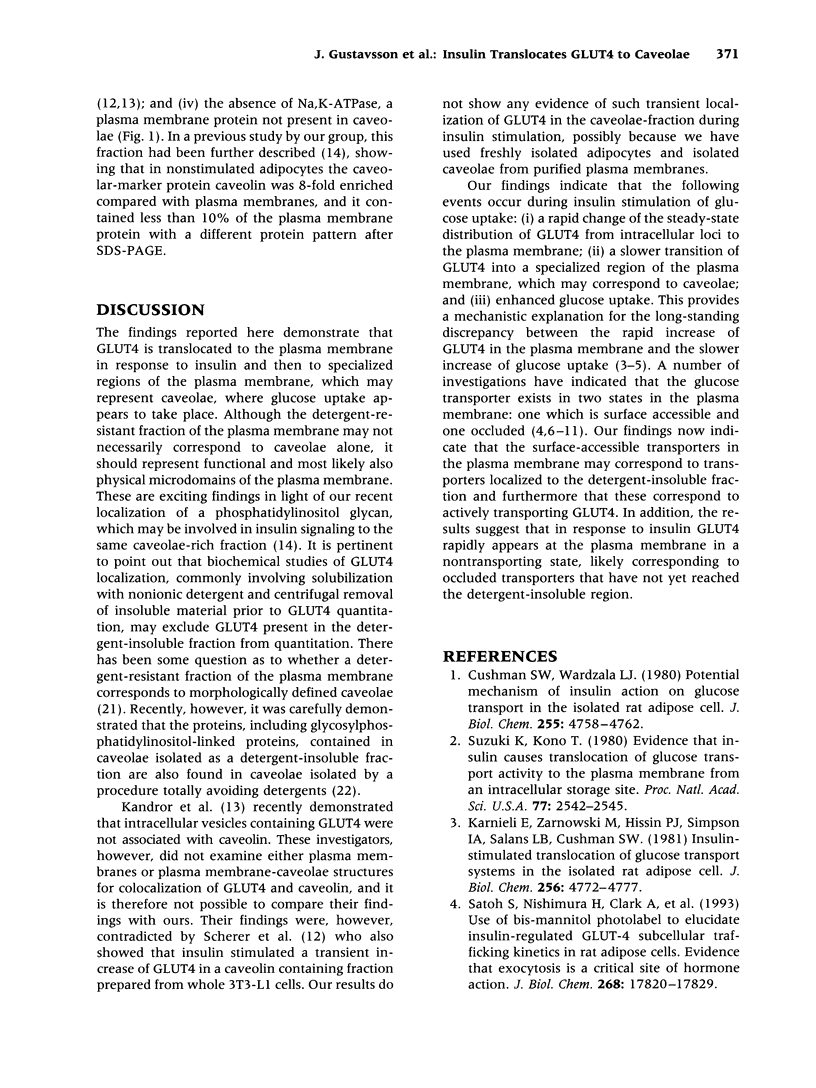
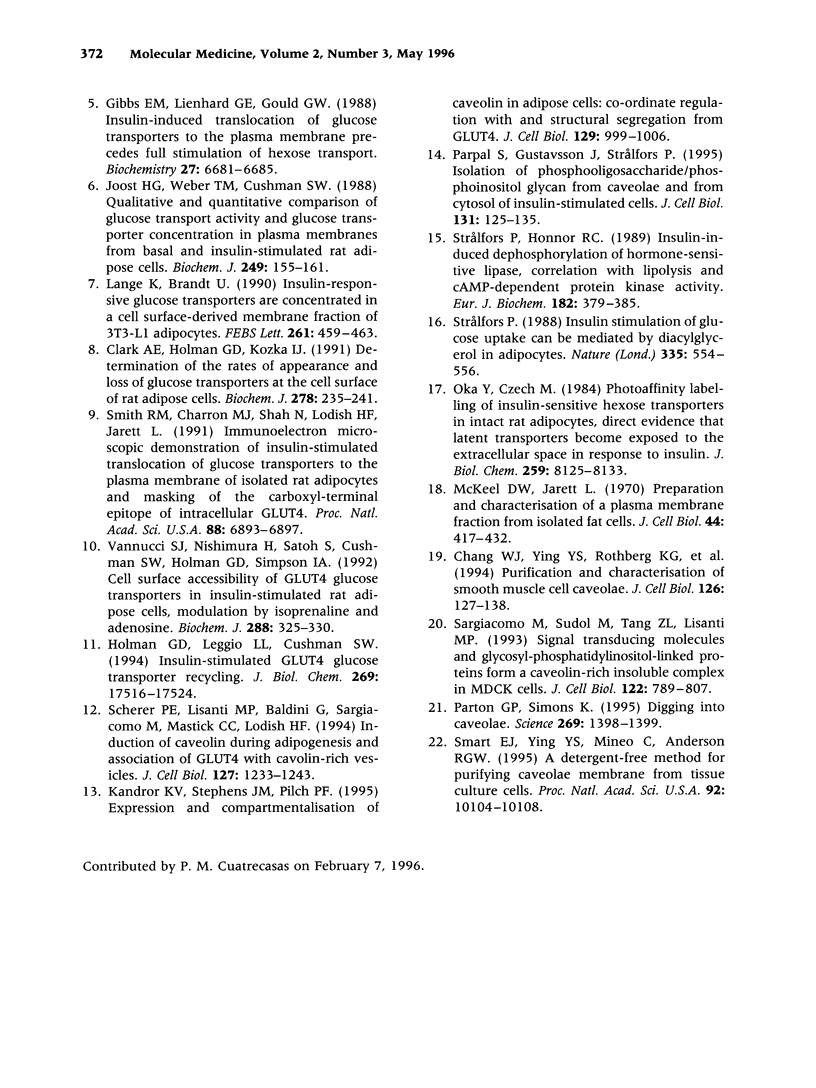
Images in this article
Selected References
These references are in PubMed. This may not be the complete list of references from this article.
- Chang W. J., Ying Y. S., Rothberg K. G., Hooper N. M., Turner A. J., Gambliel H. A., De Gunzburg J., Mumby S. M., Gilman A. G., Anderson R. G. Purification and characterization of smooth muscle cell caveolae. J Cell Biol. 1994 Jul;126(1):127–138. doi: 10.1083/jcb.126.1.127. [DOI] [PMC free article] [PubMed] [Google Scholar]
- Clark A. E., Holman G. D., Kozka I. J. Determination of the rates of appearance and loss of glucose transporters at the cell surface of rat adipose cells. Biochem J. 1991 Aug 15;278(Pt 1):235–241. doi: 10.1042/bj2780235. [DOI] [PMC free article] [PubMed] [Google Scholar]
- Cushman S. W., Wardzala L. J. Potential mechanism of insulin action on glucose transport in the isolated rat adipose cell. Apparent translocation of intracellular transport systems to the plasma membrane. J Biol Chem. 1980 May 25;255(10):4758–4762. [PubMed] [Google Scholar]
- Gibbs E. M., Lienhard G. E., Gould G. W. Insulin-induced translocation of glucose transporters to the plasma membrane precedes full stimulation of hexose transport. Biochemistry. 1988 Sep 6;27(18):6681–6685. doi: 10.1021/bi00418a006. [DOI] [PubMed] [Google Scholar]
- Holman G. D., Lo Leggio L., Cushman S. W. Insulin-stimulated GLUT4 glucose transporter recycling. A problem in membrane protein subcellular trafficking through multiple pools. J Biol Chem. 1994 Jul 1;269(26):17516–17524. [PubMed] [Google Scholar]
- Joost H. G., Weber T. M., Cushman S. W. Qualitative and quantitative comparison of glucose transport activity and glucose transporter concentration in plasma membranes from basal and insulin-stimulated rat adipose cells. Biochem J. 1988 Jan 1;249(1):155–161. doi: 10.1042/bj2490155. [DOI] [PMC free article] [PubMed] [Google Scholar]
- Karnieli E., Zarnowski M. J., Hissin P. J., Simpson I. A., Salans L. B., Cushman S. W. Insulin-stimulated translocation of glucose transport systems in the isolated rat adipose cell. Time course, reversal, insulin concentration dependency, and relationship to glucose transport activity. J Biol Chem. 1981 May 25;256(10):4772–4777. [PubMed] [Google Scholar]
- Lange K., Brandt U. Insulin-responsive glucose transporters are concentrated in a cell surface-derived membrane fraction of 3T3-L1 adipocytes. FEBS Lett. 1990 Feb 26;261(2):459–463. doi: 10.1016/0014-5793(90)80615-p. [DOI] [PubMed] [Google Scholar]
- McKeel D. W., Jarett L. Preparation and characterization of a plasma membrane fraction from isolated fat cells. J Cell Biol. 1970 Feb;44(2):417–432. doi: 10.1083/jcb.44.2.417. [DOI] [PMC free article] [PubMed] [Google Scholar]
- Oka Y., Czech M. P. Photoaffinity labeling of insulin-sensitive hexose transporters in intact rat adipocytes. Direct evidence that latent transporters become exposed to the extracellular space in response to insulin. J Biol Chem. 1984 Jul 10;259(13):8125–8133. [PubMed] [Google Scholar]
- Parpal S., Gustavsson J., Strålfors P. Isolation of phosphooligosaccharide/phosphoinositol glycan from caveolae and cytosol of insulin-stimulated cells. J Cell Biol. 1995 Oct;131(1):125–135. doi: 10.1083/jcb.131.1.125. [DOI] [PMC free article] [PubMed] [Google Scholar]
- Parton R. G., Simons K. Digging into caveolae. Science. 1995 Sep 8;269(5229):1398–1399. doi: 10.1126/science.7660120. [DOI] [PubMed] [Google Scholar]
- Sargiacomo M., Sudol M., Tang Z., Lisanti M. P. Signal transducing molecules and glycosyl-phosphatidylinositol-linked proteins form a caveolin-rich insoluble complex in MDCK cells. J Cell Biol. 1993 Aug;122(4):789–807. doi: 10.1083/jcb.122.4.789. [DOI] [PMC free article] [PubMed] [Google Scholar]
- Satoh S., Nishimura H., Clark A. E., Kozka I. J., Vannucci S. J., Simpson I. A., Quon M. J., Cushman S. W., Holman G. D. Use of bismannose photolabel to elucidate insulin-regulated GLUT4 subcellular trafficking kinetics in rat adipose cells. Evidence that exocytosis is a critical site of hormone action. J Biol Chem. 1993 Aug 25;268(24):17820–17829. [PubMed] [Google Scholar]
- Scherer P. E., Lisanti M. P., Baldini G., Sargiacomo M., Mastick C. C., Lodish H. F. Induction of caveolin during adipogenesis and association of GLUT4 with caveolin-rich vesicles. J Cell Biol. 1994 Dec;127(5):1233–1243. doi: 10.1083/jcb.127.5.1233. [DOI] [PMC free article] [PubMed] [Google Scholar]
- Smart E. J., Ying Y. S., Mineo C., Anderson R. G. A detergent-free method for purifying caveolae membrane from tissue culture cells. Proc Natl Acad Sci U S A. 1995 Oct 24;92(22):10104–10108. doi: 10.1073/pnas.92.22.10104. [DOI] [PMC free article] [PubMed] [Google Scholar]
- Smith R. M., Charron M. J., Shah N., Lodish H. F., Jarett L. Immunoelectron microscopic demonstration of insulin-stimulated translocation of glucose transporters to the plasma membrane of isolated rat adipocytes and masking of the carboxyl-terminal epitope of intracellular GLUT4. Proc Natl Acad Sci U S A. 1991 Aug 1;88(15):6893–6897. doi: 10.1073/pnas.88.15.6893. [DOI] [PMC free article] [PubMed] [Google Scholar]
- Strålfors P., Honnor R. C. Insulin-induced dephosphorylation of hormone-sensitive lipase. Correlation with lipolysis and cAMP-dependent protein kinase activity. Eur J Biochem. 1989 Jun 15;182(2):379–385. doi: 10.1111/j.1432-1033.1989.tb14842.x. [DOI] [PubMed] [Google Scholar]
- Suzuki K., Kono T. Evidence that insulin causes translocation of glucose transport activity to the plasma membrane from an intracellular storage site. Proc Natl Acad Sci U S A. 1980 May;77(5):2542–2545. doi: 10.1073/pnas.77.5.2542. [DOI] [PMC free article] [PubMed] [Google Scholar]
- Vannucci S. J., Nishimura H., Satoh S., Cushman S. W., Holman G. D., Simpson I. A. Cell surface accessibility of GLUT4 glucose transporters in insulin-stimulated rat adipose cells. Modulation by isoprenaline and adenosine. Biochem J. 1992 Nov 15;288(Pt 1):325–330. doi: 10.1042/bj2880325. [DOI] [PMC free article] [PubMed] [Google Scholar]



